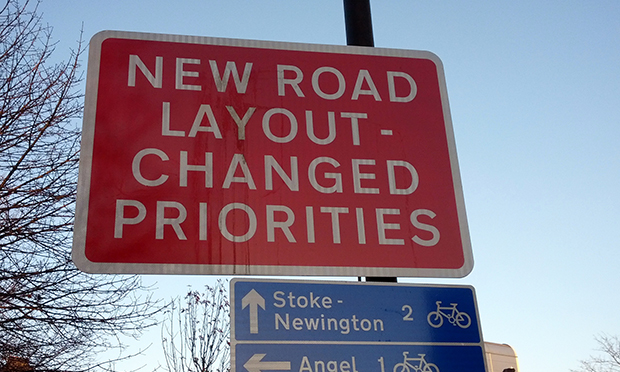Town Hall tweaks low traffic neighbourhood in Hoxton West

Photograph: Cory Doctorow/Flickr
Hackney Council made changes to one of its three recently introduced low traffic neighbourhoods (LTNs) over the weekend in response to feedback from locals and its own monitoring.
The introduction of LTNs has seen heated debate across London, with some welcoming the positive results to air quality and road safety they bring to residential streets being used as rat runs, while others complain of congestion being displaced to other areas.
The Hoxton West LTN’s traffic filter on Nile Street will now move further west, past its junction with Provost Street, to help prevent non-local traffic from using both Nile and Provost as rat runs, with transport chief Cllr Jon Burke speaking out over the weekend to warn vandals who had destroyed bollards in the area: “Cameras coming soon. When we catch you, we’ll prosecute.”
Speaking to the Citizen last week, Cllr Burke said: “We’ve always been clear that the head of service can make real-time interventions as and when issues arise, and we are keen to ensure that happens.
“Modifications to the Hoxton West scheme have been made to produce some better outcomes there. We’re always clear that some of these interventions will work, some will require modification, and some might not be suitable in the long-run at all, and we will assess that on an ongoing basis.
“Nobody said that it would never take longer to undertake certain kinds of journey. For those people for whom it is a necessary journey, I have to balance the needs of a wide number of road users through our movement hierarchy.
“If the trade-off between safer streets and quieter communities is that some essential journeys take that little bit longer, then that is an on-balance decision that I have made.”
Burke also dismissed as a “bad faith” argument any suggestion that modal filters on roads hinder emergency vehicles, asserting that when it comes to the borough’s own schemes, “it just simply isn’t true”.
The council has introduced two other LTNs in Hackney Downs and London Fields, as well as putting in another 15 traffic filters and creating 40 new traffic-calmed streets near schools.
According to the Town Hall, the government-supported measures are aimed at securing the “cleaner, greener” city seen during lockdown, as well as helping pedestrians and cyclists travel more safely with public transport capacity remaining low, with Burke adding that 70 per cent of Hackney households do not own a car.
The transport chief revealed that similar measures could have been implemented in the past, if “more support” had been forthcoming from former Hackney Mayor Jules Pipe, going on to say: “We are a different kind of administration, and we are now doing the job that people have asked us to, and that we said we’d do in our transport strategy.”
All the schemes in recent months have been introduced under experimental traffic orders (ETOs), a measure made under the Road Traffic Regulation Act by which a change is introduced for a maximum of 18 months before a decision is made on whether to make it permanent.
The council has accepted that there could be “disruption and inconvenience” for a number of weeks as drivers become acclimated to the changes and navigation apps adjust to the new layouts, which are designed to limit traffic displacement, though Burke has moved to reassure locals that the Town Hall is monitoring traffic levels around where changes have been made.
The transport chief has said that if higher levels of traffic than normal are seen on a road near an LTN, it would likely die down, potentially in “a number of weeks”, adding that other factors are creating temporary increases, including Transport for London roadworks on Hackney Road and Thames Water works in Stoke Newington.
All the new measures are designed to actively discourage non-essential journeys in private cars, with the Town Hall believing that this will ultimately reduce congestion, making the roads clearer for blue badge holders, and emergency and commercial vehicles.
Burke added: “We’ve sought to create through LTNs whole neighbourhoods in which our movement hierarchy and our priorities are abundantly clear. Our priorities, as in the case of the Cat & Mutton Bridge closure, are pedestrians, cyclists and public transport users.
“All three of those groups are favoured by LTNs, and then you have the broader benefits of calmer streets and people feeling safer, more secure and less harassed in their communities, which will no longer be treated as pressure release valves for a main road system that is overloaded with cars.
“As people go back into work and decide not to use public transport to do so, for the people who claim that LTNs cause congestion, which couldn’t be further from the truth, those people need to understand that if we continue on the trajectory that we are, our roads will be clogged in no time at all.
“It’s easy for national governments to freeze fuel duty or to trumpet the automotive industry in this country. Telling people they can have more stuff, irrespective of the consequences of that stuff for other people, is politics on easy mode. Ultimately we are left with the consequences of that, and have to show some leadership in the problems that arise from it.
“With some groups of people that is not going to make you very popular, but you can’t make decisions based on whether it makes you popular, but on where the evidence leads you.
“I accept that some of these changes are big changes, but if you take the broader view of the climate crisis that we face, weaning ourself off motor vehicles is absolutely essential, and if you think a few LTNs are disruptive, go and look at what’s going in California, the Amazon, the Greenland ice shelf. If you don’t like inconvenience, I have bad news – inconvenience is coming for us in a big way.”
